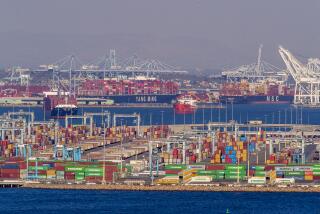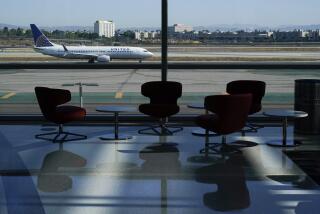Airports Brace for Turbulence
- Share via
The nation’s commercial airports, already reeling from a drop-off in travel spurred by a prolonged recession and the Sept. 11 terrorist attacks, are bracing for another downturn as the beleaguered airline industry restructures.
The recent bankruptcy filing by US Airways Group Inc. and the threat of similar action by United Airlines parent UAL Corp. may place improvement projects and some airports’ credit at risk. And revenue sources that airports rely on, such as passenger concessions, could be reduced as airlines further reduce capacity.
At Los Angeles International Airport, where passenger totals are at six-year lows, officials are concerned that United again will cut its schedule. The carrier, the airport’s largest tenant, canceled 40% of its flights at LAX last fall and has said it won’t add any back until more people start flying.
Elk Grove Township, Ill.-based UAL generates about 20% of LAX’s aviation revenue through landing fees and rent for space in Terminals 6, 7 and 8 and maintenance and cargo facilities. Under a use agreement with the city, which is similar to those at other airports, United would be responsible for these fees even if it filed for bankruptcy protection. The airline pays the airport $42 million a year in landing fees and rent.
But analysts called this long-accepted tenet of airport finance into question recently: “Under a Chapter 11 bankruptcy scenario, a terminal lease would be considered ... [a] contract that [a] debtor airline would have the option to either accept or reject as it reorganizes,” analysts for Moody’s Investors Service wrote in a May report.
Recent announcements by US Airways, AMR Corp.’s American Airlines and Continental Airlines Inc. that they will cut their winter schedules threaten to hammer concession and parking revenue just as many airports are initiating million-dollar facility upgrades to meet federal security mandates.
“Our concern doesn’t lie so much in terminal rents and landing fees as it does on concessions and parking if fewer planes and fewer people are flying,” said Karen Sisson, chief financial officer for Los Angeles World Airports, the city agency that operates LAX.
Concession revenue--the airport agency’s second-biggest money maker after aviation revenue, which includes terminal rents and landing fees--fell 35% last year and is expected to be down 30% this year. Security costs, meanwhile, are projected to nearly double to $68 million this fiscal year, which began July 1, from $35 million last year.
If United announces additional cuts, LAX officials would do what they did after Sept. 11--slash expenses and tap the agency’s healthy reserves, Sisson said. But that would not be easy because the airport agency’s $790-million budget for this fiscal year already is incredibly tight, she added.
Even with these worries, LAX is more fortunate than airports that rely heavily on a single airline to generate traffic.
“LAX is in an enviable position given its modest amount of debt, diversity of carriers and high amount of origin and destination traffic compared to other hub airports,” said Dan Champeau, a managing director at Fitch Ratings, which rates airports’ ability to service debt.
LAX’s $234 million of general revenue bond debt currently carries an investment-grade rating of Aa3 by Moody’s.
A large number of travelers who pass through LAX are entering or leaving the system, not catching other flights like passengers at major connecting hubs such as Chicago’s O’Hare International Airport. This makes LAX less vulnerable to ups and downs in the airline industry.
Similarly, Southern California’s regional airports said their reliance on a number of airlines to provide service--10 carriers fly out of John Wayne Airport and six use Burbank Airport--will help shelter them from the airline industry’s ongoing financial difficulties.
But hub airports that rely on one carrier for much of their passenger traffic and revenue, such as San Francisco International Airport, may need to issue more bonds to cover costs and are more likely to pay higher interest rates and insurance premiums for this debt.
Moody’s revised the outlook for SFO’s bond debt to negative following the terrorist attacks after United, which accounts for 47% of the facility’s passengers and 50% of its landing fees, cut its schedule there. But the facility’s new international terminal, which opened in December 2000, should generate traffic and help SFO bounce back, said airport spokeswoman Kandace Bender.
Denver International Airport also is a major United hub--the airline and its express partners account for 62% of the airport’s passengers. DIA officials recently conducted a “financial stress test” to determine how DIA would weather a United bankruptcy. The experiment assumed that the nation’s second-largest carrier would cut 20% of its schedule at DIA.
“The test found that revenue would be down,” said Chuck Cannon, an airport spokesman. “But not to the point where we couldn’t meet our obligations for operations and maintenance and the debt service on almost $4 billion in bonds.”
But other United hubs, like Chicago’s O’Hare, already are suffering. United and American announced last month that they can no longer afford to invest in a long-awaited $3.6-billion terminal project there, forcing officials to postpone it.
The two carriers, which control more than 85% of O’Hare’s flights, said they hoped to regain financial health by the time a separate $6.6-billion plan to build two new runways and reconfigure others gets underway.
Officials at some major hubs are looking for an upside to the airlines’ financial problems. At Philadelphia International Airport, where US Airways controls more than 65% of the gates, officials have speculated that a move by the carrier to cut its schedule might allow competitors to enter the market and lower prices.
Passengers at Philadelphia paid fares that were 21% higher than the national average in the third quarter of 2001, according to the Transportation Department.
Low-cost carriers may benefit from the industry turmoil by filling abandoned slots at airports, analysts say. This is certainly true at LAX, where Southwest Airlines has made it no secret that it needs additional space to ease crowding in Terminal 1.
Since the terrorist attacks, lines to board the discount carrier often stretch to Terminal 2 and beyond. US Airways has 10 flights a day out of Terminal 1. If the carrier cuts service, its gates surely would be filled, officials say.
This ever-present demand for air service historically has helped airports survive the cyclical nature of the airline industry. For example, Houston George Bush Intercontinental and Newark Liberty International airports, longtime Continental hubs, are thriving, about a decade after the carrier emerged from bankruptcy, said Kevin Carney, vice president and senior credit officer at Moody’s.
“Since deregulation in 1978, over 125 airlines have filed for bankruptcy, but we’ve never seen an airport bond default,” said Fitch’s Champeau. “The overall demand for air travel has always been there, and will continue to be there at some base level, no matter which airlines are operating.”
More to Read
Inside the business of entertainment
The Wide Shot brings you news, analysis and insights on everything from streaming wars to production — and what it all means for the future.
You may occasionally receive promotional content from the Los Angeles Times.










